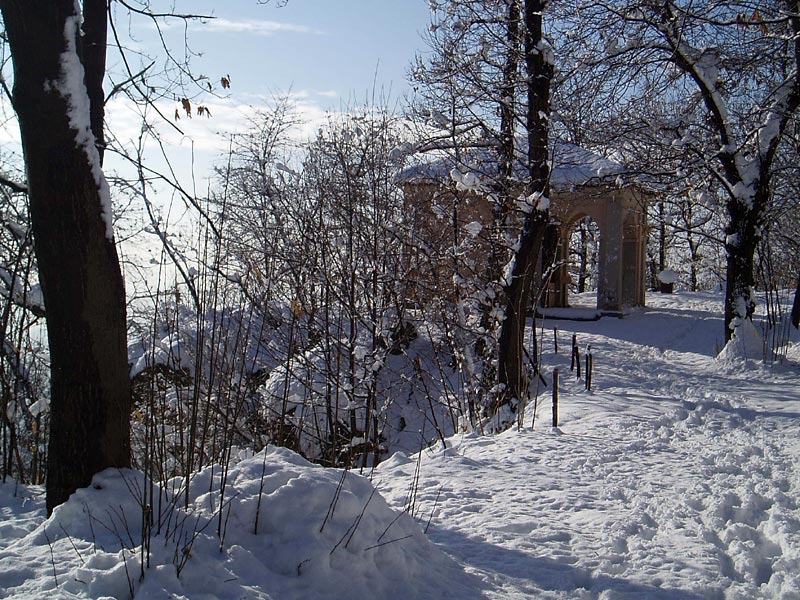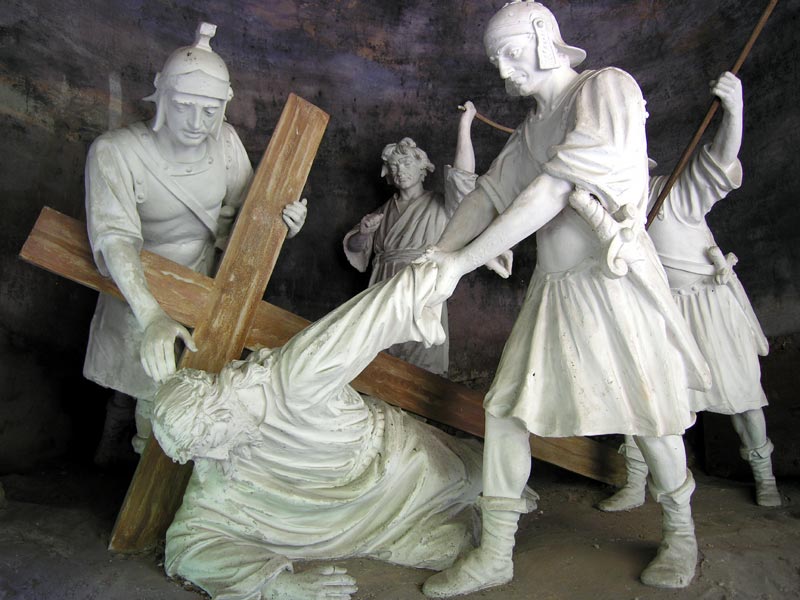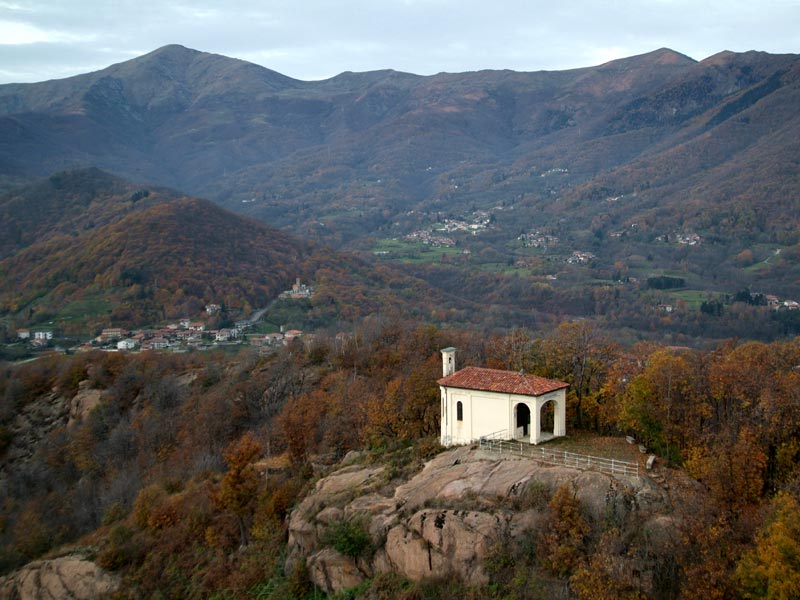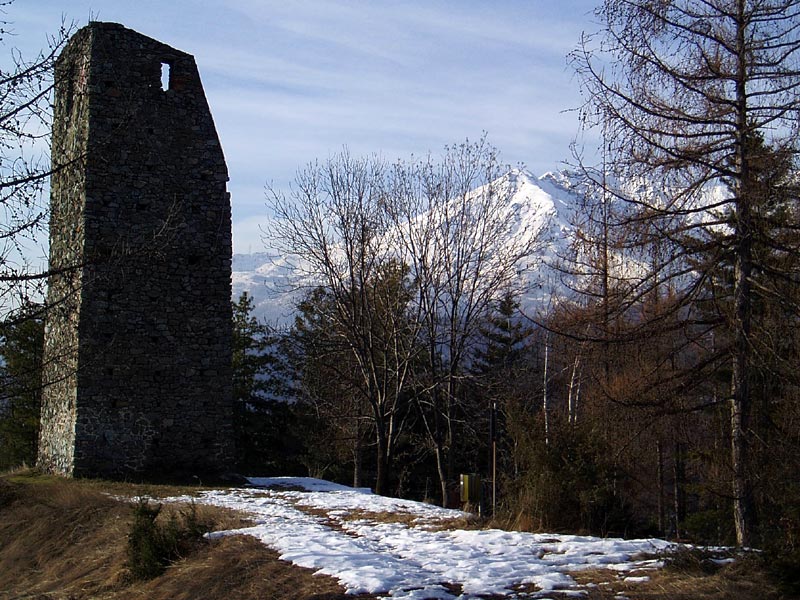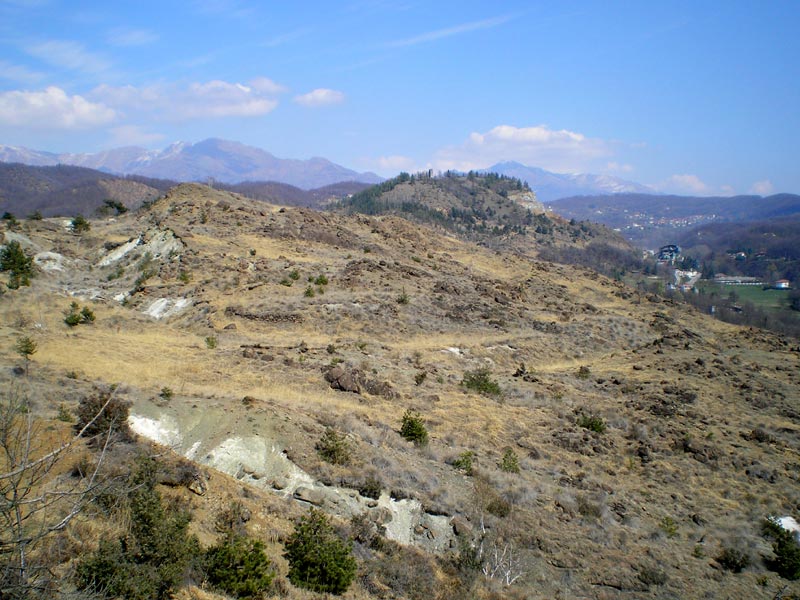Points of Interest
Sacro Monte di Belmonte
On 5th July 2003, Sacro Monte di Belmonte together with the other Sacred Mountains of Piedmont (Crea, Domodossola, Ghiffa, Oropa, Orta, and Varallo) and the Sacred Mountains of Lombardy (Ossuccio and Varese) were declared by UNESCO "World Heritage Sites". Such recognition was decided by an international committee of experts with the following description: "The nine Sacri Monti (Sacred Mountains) of northern Italy are groups of chapels and other
architectural features created in the late 16th and 17th centuries and
dedicated to different aspects of the Christian faith. In addition to
their symbolic spiritual meaning, they are of great beauty by virtue of
the skill with which they have been integrated into the surrounding
natural landscape of hills, forests and lakes. They also house much
important artistic material in the form of wall paintings and statuary".
The inscription in the UNESCO list imposes "the obligation to ensure the identification, safeguard, preservation, enhancement, and transmission of the cultural and natural heritage to the future generations".
Some History
Since 1712, also the highest part of Belmonte dominating the sanctuary became a place of worship thanks to the Franciscan friar Padre Michelangelo from Montiglio, who planned the lay-out along which the chapels of the "Via Crucis" should have been built. He built some of these chapels with the help of both pilgrims and the local communities who supported this project. When Padre Michelangelo left, the project was continued by the other Superiors of the sanctuary, and was completed towards the half of the 19th century. The 14th chapel of the Deposition is lacking, since it was incorporated in the building of the monastery.
The devotional route of Sacro Monte di Belmonte is formed by 13 chapels representing the Passion of Christ. They are characterized by the same building typology, dry and essential, with one hall, circular or quadrilateral plan, preceded by a pronaos from where you look at the sacred scene.
- Chapel no. 1 - Jesus in front of Pilate
The chapel, with circular plan and rectangular pronaos, was built in 1712. The frescoes on the vault, well preserved, are ascribed to the painter Grosso from Ivrea and date back to the 18th century. - Chapel no. 2 - Jesus is condemned to death
The chapel, with a circular plan, was built in 1714. - Chapel no. 3 - Jesus falls the first time
The chapel, with rectangular plan and pronaos, was built in 1715. The more recent restoration works were carried out in 2002. - Chapel no. 4 - Jesus meets His Mother
The chapel, with rectangular plan and pronaos, was built in 1713. - Chapel no. 5 - Simon of Cyrene carries the cross
The chapel, with rectangular plan and pronaos, was built in 1773. - Chapel no. 6 - Veronica wipes the face of Jesus
It is the farthest chapel, situated in a wonderful panoramic position, and marks we are halfway of the devotional route. It was built in 1712. It is the chapel suffering more damages and acts of vandalism: as a matter of fact, the group of statues was completely destroyed. At the beginning of the current century, it passed under the patronage of the Lawyer Aurelio De Andreis, who transformed it into a family Chapel, adding an apse with an altar and a small bell tower. - Chapel no. 7 - Jesus falls the second time
The chapel, with rectangular plan and pronaos, began to be built in 1715. The building was finished only in 1773. The vault of the Chapel was painted in fresco by the painter Grosso from Ivrea in 1773. - Chapel no. 8 - Jesus meets the daughters of Jerusalem
The Chapel, with circular plan and rectangular pronaos, began to be built by the friars of the monastery in an uncertain period and was finished in 1781 thanks to the support provided by some families from Busano. The vault still preserves the frescoes by the painter Grosso. The more recent restoration works were carried out in 2002. - Chapel no. 9 - Jesus falls the third time
The Chapel, with circular plan and rectangular pronaos, was built between 1759 and 1765. The group of statues is unique, since the five statues dating back to the beginning of the current century are in white plaster with no color. They stand out on the gloomy background. - Chapel no. 10 - Jesus is stripped from His garments
The chapel, with rectangular plan and pronaos, was built in the same years of the previous one and financed with the alms collected by the Sanctuary. - Chapel no. 11 - Crucifixion
The chapel, with rectangular plan and pronaos, was built in 1719. The more recent restoration works were carried out in 2002. - Chapel no. 12 - Jesus dies on the cross
The chapel is different from all the others both for its position, dominating the Sanctuary and the Monastery, and the Bramante-style shape (central octagonal plan with a large portico surrounding it). It was built in 1715 by Valperga Community which preserved the patronage and reconstructed it after the partial collapses of the second half of the 18th century and 1825. - Chapel no. 13 - Deposition
The Chapel, with circular plan and rectangular pronaos, is the last chapel of the devotional route, and the last to be built. As a matter of fact, it was built only in 1825.
In front of it, in the highest point of the mountain, there is the bronze statue representing St Francis. The statue was created by the sculptor Giovanni Vogliazzi from Vercelli, and was inaugurated on 3rd July 1960.
The Archaeological Site
The archaeological excavations revealed that Belmonte hill was inhabited already in the late Bronze Age and in the early Iron Age. There are evidences of a big settlement on the gentler slope of the hill where people used to hunt, breed animals, mill cereals - wheat, barley, and millet - and cook the food in the huts. Crockery and cinerary urns have also been found in a small depression near S. Apollonia church, a place considered sacred near the pedestrian path connecting Valperga with Sacro Monte di Belmonte.
The presence of man in the area continued both in the Roman and the Lombard period. In the area called "del Campass", it is still possible to see the foundations of a Lombard fortified house, similar to a village surrounded by a wall. Excavation campaigns have brought to light interesting finds like everyday objects, arms, and jewels of fine workmanship. One of the halls that have been found could be a forge for the processing of metals and the creation of working tools and arms.
The 'sabbionere'
Belmonte hill has not suffered phenomena of glacial erosion. The rocks forming it date back to over 300 million years ago and are formed by an outcrop of orthoclase microperthite red granite. Among the minor minerals forming the rock structure there are quartz and plagioclase and, in lesser percentage, muscovite, biotite, iron oxide, apatite, and pyrite.
The atmospheric precipitation and the erosion phenomena given to physical and chemical agents have broken up the rocky outcrops and given origin to the so-called "sabbionere": they are gully-like structures characteristic of the area, formed by coarse sand consisting of quartz and feldspar which, according to the location, are reddish-violet or entirely white. "Sabbionere" are well visible especially on the northern slope of the hill, where the erosion phenomena are more evident.
San Giorgio Church
On the hill dominating Valperga Canavese, near the castle at its
border, there is the monumental church dedicated to San Giorgio.
The most ancient document we have about it dates back to 1150, but the
Church already existed at that time and it was the chapel of the nearby
castle owned by the Lords of Valperga and at the same time the parish
church of the village situated below. The bell tower, with its elegant
marble mullioned windows with two lights can also be dated back to that
period.
The Church is exposed to the East. According to the criteria of the
Romanesque architecture, the entrance is in the West and the apse in
the East, which represents the passage of the believer from darkness to
light. It is a building with a nave and two aisles, without transept,
40 meters long and 22 meters wide, the result of the blending of
different building periods.
At the entrance of the Church you can notice that the abse axis is
slightly shifted on the left with respect to the nave axis. It seems
not to be a mistake, but rather a symbolic representation of the
inclination of the head of Christ on the Cross.
In the 18th century a wall was built and many interventions carried out in the attempt to make the church straight.
The restoration which began in 1937/1939 will give back ancient
frescoes (by Giovanni di Pietro de Scotis from Piacenza, maybe dating
back to 1462).
During a plague (maybe the one of 1630) the church was used as a
lazaretto, and for sanitary reasons the frescoes were covered with
lime. This allowed to save the frescoes from degradation.
The whole church of San Giorgio was also painted in fresco outside, and
it was enriched with reliefs in fired brick: the only witness which has
remained is the scene of the Adoration of the Magi.
Torre Cives
"The place is situated at the top of a highly washed away relief with
calcareous schists, with limestone and magnesite breccia, and
considerable opal outcrops... A territorial survey carried out in 1984
along the excavation fronts of the access road at the top and in the
square has led to the recovery of some fragments of terracotta
associated to iron scoriae. They consist in a few fragments of brown
and not turned ceramics, except for a fragment. Among the shapes it is
possible to recognize only an hemisferical bowl and the foot of a vase
with an open truncated-conic plant. These finds could be dated back to
a period going from the late Prehistory to the High Middle Age. The two
scoriae fragments are laminated, compact, a little oxidized, smooth,
almost without vacuoles".
From "Rivista di Archeologia" - Anno XI - 1987 - director: Gustavo Traversari - Università degli Studi Venezia.
The "tesoretto"
"The 'tesoretto' of Torre Cives consists of five golden coins
dating back to the Byzantine period: one of Leone I and the others of
Basilisco. They have been found in 1956 by some workmen during the
restoration of a non-asphalt road leading to the Torre".
From "Contributi sulla romanità nel territorio di Eporedia", Giorgio Cavaglià - 1998
The solids of the two Emperors
The five golden medals are described in a 1956 document of the Monuments and Fine Arts Service of Piemonte.
- No. 4 solids of th Emperor Basilisco (476-477), made in Italy:
Front/ Bust with helmet and armour of the Emperor with the lance on his shoulder.
"D.N. BASILIS-CVS PRET AVG".
Rear/ Victory on the left, with a long cross. In the field on the right, a star. "VICTORI-A AVGG".
Exergue: "COMOB".
Total value: about 37 Euros - No. 1 solid of the Emperor Leone (457-473), made in Constantinopole:
Front/ Bust with helmet and armour in front of the Emperor with the lance on his shoulder.
"D.N. LEO PE-RPET AVG".
Rear/ Victory on the left, with a long cross. In the field on the right, a star.
"VICTORI-A AVGGGA".
Exergue: "CONOB"
Total value: about 6 Euros
From "Atto di stima delle monete", 18th May 1956 from the Monuments and Fine Arts Service of Piemonte.
"The 'solids' of Vidracco are coins coming from a dark historical
period, and they were let out in Constantinopole: the coin of Leone I
has been preserved in a wonderful way, and it belonged maybe to the
emissions of the end of his kingdom (474). The four coins of Basilisco
have also been perfectly preserved. They arrived in Vidracco between
476 and the first half of 477. According to the experts, the coins
could be used for commercial exchanges between this area of Piemonte
and the port of Genova".
From "AD QUINTUM", Bollettino del Gruppo Archeologico di Collegno - 1972




